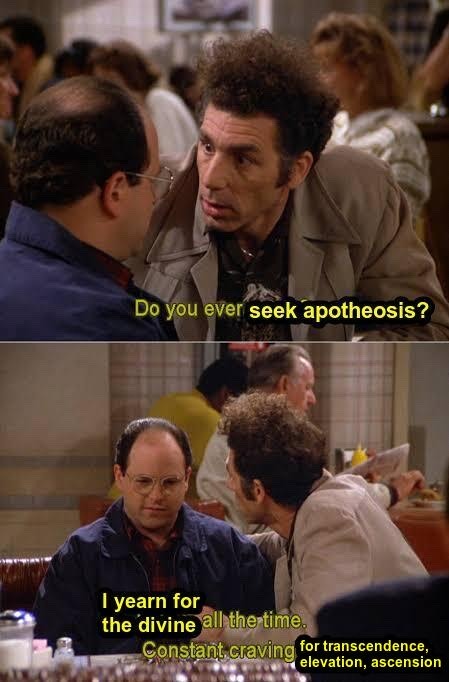Text
The purpose of practice is not to increase knowledge but to scrape the scales off the eyes, to pull the plugs out of the ears.
— Novice to Master by Soko Morinaga
46 notes
·
View notes
Text
In Scotland and parts of the British Isles, we find The Devil’s Acre as a sort of offering to the Wild Adversary, called sometimes ‘The Gudeman’s Croft’ or ‘Cloutie’s Croft’. This is where a good piece of the pasture is left wild, given as an offering to the Devil, out of respect and fear. This piece of ground was not ventured onto nor put into any sort of production, as it was left in the Devil’s service. Ulstermen from Ireland called this ‘The Devil’s Half Acre’ or ‘The Lone Acre’. A name from England for it was ‘Jack’s Land’. Even from New England, it was spoke of as ‘leaving the tithe to nature’. One seed-planting incantation from nineteenth century Suffolk went: ‘Four seeds in a hole, One for the birds, One for the mice, and One for the Master’.
Another from Ashe County, North Carolina simply goes: ‘This is for me, This is for my neighbor, This is for the Devil’. This notion that the Devil must have his share of the bounty of the land is no doubt a remnant from ancient times, where offerings to local land spirits were part of planting and harvesting practices. The power of the Old One, similar to the denizens of the Faerie realm, having the supernatural ability to bestow a blessing or curse upon the land, was taken seriously in times past. Regular offerings and acknowledgement were in order.
Corinne Boyer - Plants of the Devil
235 notes
·
View notes
Text
She is the lady of drunkenness, the queen of the dance. She stabs the enemy, drives back the rebels, kills off the enemies in the place of internment; she is Sekhmet the great, who has power over the masses - the countless crowd trembles upon seeing her.
-Offerings to the Gods in Egyptian Temples, Sylvie Cauville
133 notes
·
View notes
Photo
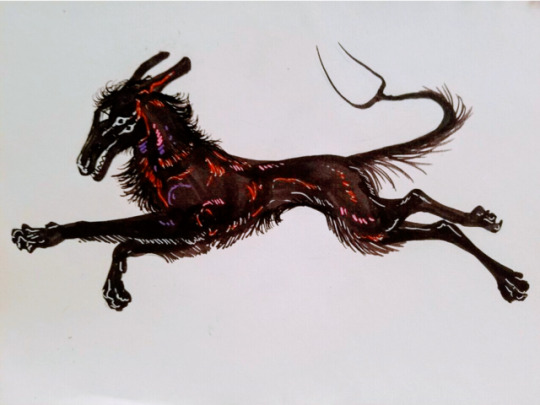
Old sketch I forgot to upload. My half of an art trade with @the-typhonian of their sha character.
124 notes
·
View notes
Text
“The ability to feel ‘with’ rather than ‘for’ is the essential difference between consciousness and emotion. When we feel for things we are emotionally moved. Pity, sympathy, and kindred feelings stir us, and yet they seldom give any definite impulse that is of value in the adjustment of any chain of circumstances. When we feel with things we are so much a part of them that we understand the innermost elements of their being. Thus understanding comes with consciousness…”
— Manly P. Hall
40 notes
·
View notes
Note
🍷 are you a soft or a hard polytheist? Do you believe that all divinity are faces of the same divine force, or perhaps that God/the Creator and the Devil are simply two faces of one being?
Personally, I do not follow either approach, nor do I think either one is strictly historic or, necessarily, factually accurate.
In the core of my understanding, - or, rather, the conclusion I am willing to settle on presently, - is that all mythos is the result of the interaction between the divine and the human perception. In that sense, whether gods are wholly separate, one, or at all existent is fundamentally unknowable; we can only have faith in what makes sense to us.
The ancients certainly had the ability to differentiate between the gods of different tribes and lands; still, often enough one divinity was explained through another one, which would at least speak to the people's understanding of both, if not to the belief that they are the same. Judging by the fact that different sets of gods were primarily honoured in different areas even under the same ethnic umbrella, it may also be concluded that no one pantheon is, strictly speaking, necessary to have a religious practice that satisfies people's spiritual and ritualistic needs.
It is my personal opinion, too, that the spirit world more or less responds in the way it is approached, and does not shy away from wearing the face that shall get the job done and make them recognisable as a bearer of a particular purpose and qualities, rather than fussing about being seen as that one particular spirit - unless, of course, it is something that is important to them, ha.
None of that, however, tells much about what I personally believe, now, does it?
My view is that gods are what they are, only in part overlapping with what humans can perceive, know, or tell about them. Different religions, in the sense of a set of defined views and rituals, provide perspectives and approaches, not necessarily being, or needing to be all-encompassing. They shift, merge, divide, layer over each other and, ultimately defy strict definition. Their purpose is in the service of a living relationship, not in forming a correspondence table. If you will, religion is the dress worn by the divine so that we can have a face to talk to. I believe that neither the gods are all the same, nor that they are all separate and strictly divided between patheons.
Moreover, it is my conviction that it is respectful to approach a spirit in their preferred way, whatever you are able to agree upon. Certain saints, for example, may well in truth function as keys for reaching what one would consider pagan divinity - still, they come to you as a saint. Until they shed the cross, if they do at all, this is the way they wish or find it convenient to be seen.
I do not believe in the Devil, however - although there are, without a doubt, beings that may be called thus.
125 notes
·
View notes
Note
This is kind of a large question so I apologize but I guess I'm curious on how you're able to get such specific or like. unique (i mean this in a good way) answers from tarot? Like your "what magic should i learn next" stuff or how to pick up what a spirit can do through tarot. like idk how to translate these cards into what the spirit is trying to say
Hi!
There's no easy answer to this question, partially because I've now been reading tarot for almost exactly 16 years. This isn't at all to say that it's just the passage of time, but that in that amount of time I've done tons and tons of different things to expand my understanding of, and usage, of tarot.
Tarot didn't come to me very easily, and part of that journey was doing a lot of experimentation in an effort to figure it all out. My reading practice is still very much typified by a huge amount of experimentation and custom reading methods.
It hasn't been a linear process at all. I go through periods of months (or more!) where tarot just doesn't click for me, at all. So just because I picked up my first tarot deck 16 years ago doesn't mean that I've kept a consistent practice (I'm just now getting back into it after just such a fallow period ^-^)
My feelings on experimentation is that it gives me new ways to think about not only the cards, but also spreads, methodologies, and readings as a whole.
In addition, my experiments with other forms of divination (most especially casting lots, energy readings, and playing card readings) have heavily influenced my tarot readings.
Here is a post I wrote that I think expresses my feelings on experimenting within tarot.
Here are some examples of tarot experiments I've performed, and/or methodologies I've explored. It's these sorts of things that have been building blocks in my abilities in tarot. But no single one of them was a "key."
Elemental dignities: The elements of the cards dictates how they interact with each other. Air + fire can mean a supercharged firestorm, but water + fire can mean a controlled fire under a stewpot, or blocked progress of the fire. This experiment helps with understanding how cards can link together, and how energy can flow within a spread.
Elemental landscapes: Spreads are laid down in lines or grids and each card represents one aspect of the landscape. You must brainstorm and choose your own meanings. E.g., 8/wands is an exploding volcano. Queen/Cups is a lake inhabited by mermaids. Read the flow of weather patterns and energies through the spread as an answer to the question. This experiment helps with intuitive reading and working with a spread as a whole, instead of focusing on individual cards.
Elemental portents: Assign an element to your question. Draw a card. If the element on the card agrees with the element of your question, the portent is good; if it disagrees, the portent is bad. This experiment helps with learning how to phrase questions and how the question themselves can influence the balance of the deck.
Astral landscapes: This was an elaborate system I built around the Wooden Tarot. I worked with each card to assign it a mystical association that could occur in an astral landscape. The major arcana were spirits who could travel across the landscape. Each spread was like a playing board of a generated landscape and the spirits that interacted inside of it. This experiment was fun for considering the metaphysical ramifications of the energies of the cards themselves.
Numerical virtues: The number value of the card indicates its power and magnitude in the spread. 2 and 3 value cards are always of smaller power and significance. 10 and court cards are always of higher value. Aces may be high or low. This experiment gave me a new way of thinking about importance of each card, and how to blend magnitudes of significance.
Infinite directional wheel: I wrote a post on this actually, but basically you can keep placing cards forever in the cross-quarter positions. It's a meditation on the concept of elements and directions within witchcraft. Also, an extremely useful spread. This was a vital experiment for me in understanding spreadwork, flow of information, and linking cards.
Card doubling and tripling: Place two (or 3) cards together and determine the meaning as if it's one single card; there is no border, and the images combine with each other. The pictures and meanings of each combine into a single card.
Card doubling and tripling, but in spreads: For each position in the spread, place two cards (or three cards!) in place of one. Read the dyads or triads as if they are a single card. It isn't beginning/middle/end; it's a single triple-complex card! These doubling experiments helped me with the concept of card linking and blending meanings into unique interpretations.
Custom meaning sets: Basically, swap out all the default meanings with your own. Extremely useful IMO in learning how sets of meanings work together, and how to balance sets of meanings. I wrote a post on it here. These experiments have perhaps been the most vital for me in developing new interpretations. I believe that the magical skills readings you referenced were the result of custom meaning sets.
No meaning sets: Instead of using any card meanings, all spreads are resolved using a combination of elemental portents and numerical virtues. I.e., the element and number of a card in relation to other cards in the spread determines the reading. Here, the experimentation is allowing the cards to have strict, defined roles within a spread that can't be overwritten by personal intuition.
As a final note, I highly, highly recommend recording every reading you do and every card you draw. For the first couple years of my practice I recorded all readings, and it was a huge boost to my learning.
55 notes
·
View notes
Text

what the fuck did I just download
16K notes
·
View notes
Text
I am the making and the unmaking;
I am building and dissolution;
I am the love-crowned Sovereign.
I am the weaving that pulls on the strings;
Blessed is my word and my hand,
And what-is rejoices in my will.
I am the rose, the oil, the holy earth;
I am the joy of my being;
I am the light, and the shadow is in my grasp.
The key, the lock, the tongue; so it is.
- Sanctification of the witch, by C. Winter
The lines draw upon terminology and understanding within a personal craft. While you are welcome to draw inspiration from them, using them as-is is unadvisable.
71 notes
·
View notes
Text
ok sports fans, here's the deal. we are gonna have a little lesson in making
UNCROSSING BATHS
because in the past week I have dumped a pitcher of water onto a power strip, driven the car into the garage with the TRUNK OPEN which got it lodged on the garage door and scratched it up, dropped my phone in a bowl full of water (and spinach), broken my glasses, overwatered the plants so they leaked all over some boxes of books, and generally been uncharacteristically fucking things up.
which means: UNCROSSING TIME!
46 notes
·
View notes
Text
Raffle: Braided Crabapple Stave (OPEN)

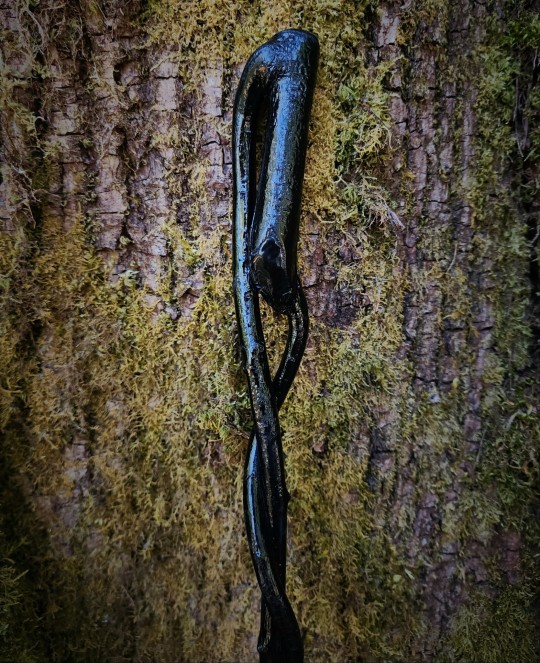
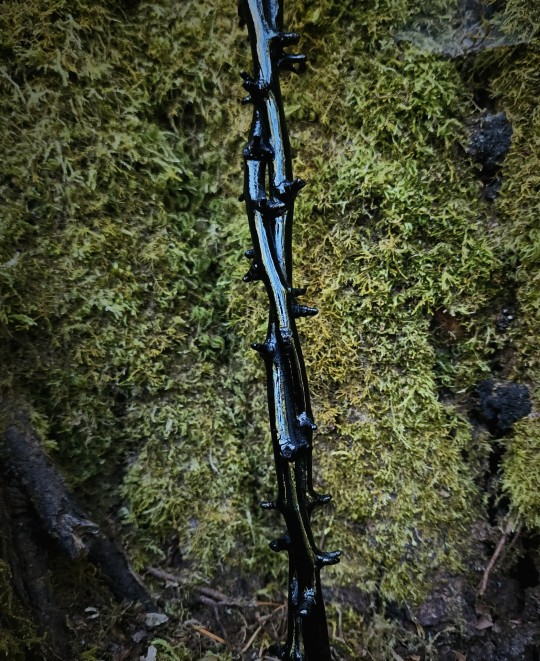
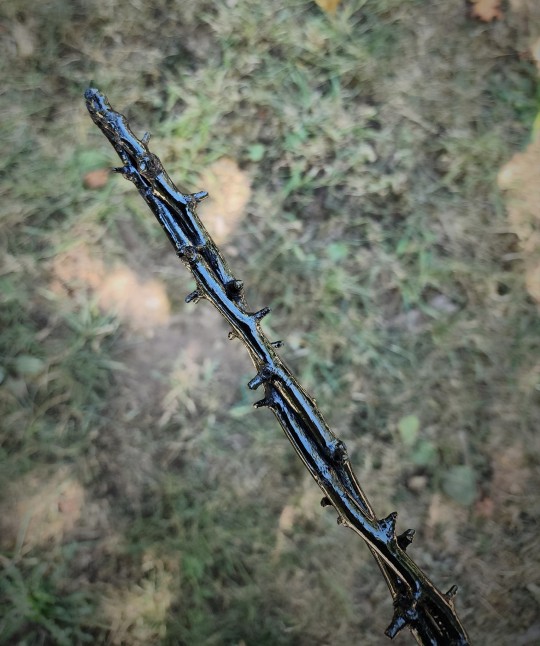
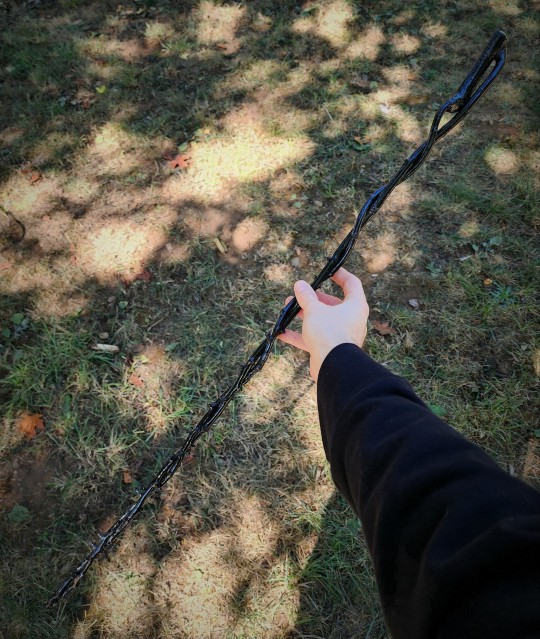
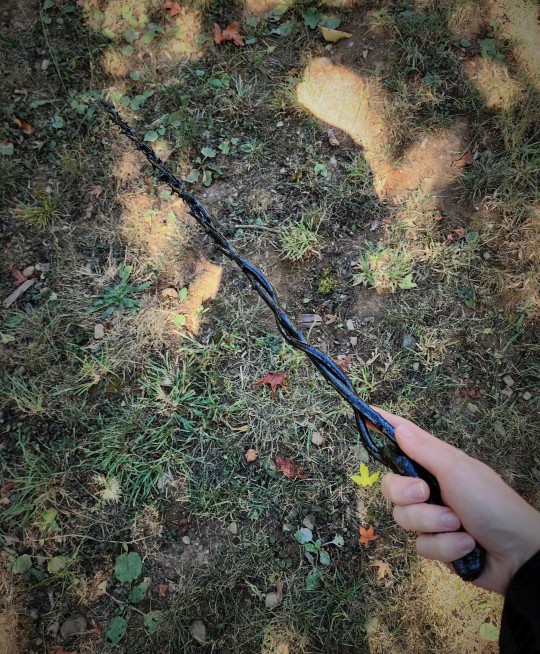

This raffle is for a unique Stave of braided, thorny wood that harvested from a 120+ year old Crabapple tree. It measures approximately 34 inches/86 centimeters in length and 1.5 inches/4 centimeters wide at its thickest point.
After initially acquiring the rare specimen in question, I went about curing the wood, smoothing the ends, and cleaning up some ragged branch stumps. While I usually debark pieces of this sort before working on them, the particular helical structure and profusion of thorns made me worried about being able to strip and sand the piece without damaging it. As such, I instead gave it a thin coat of handmade Dragon's Blood varnish to help stabilize and prime the wood, and then went about staining the entire piece using a polymerized oil pigment I make from Hearth Soot (Creosote) harvested from the interior of our Wood Stove. I applied layer after layer of the pigment until the bark was thoroughly coated and preserved, then used a cloth and my homemade Wisefool’s Oil (a ritually crafted oil of empowerment that also serves as a wonderful wood conditioner) to polish away the excess, before sealing the piece with my personally developed Wisefool's Glaze (a ritually empowered wood varnish made from an array of potent arboreal resins.) Finally, I gave the stave one last protective coating of polyurethane and suffumigated it with a smoke of Apple Blossoms and Dragon's Blood in a simple rite of hallowing.
While the retail price for this item is $200, I am taking the risk of setting up this raffle, in hopes that it might aid me in raising enough money to help us ease the cost of emergency surgery my dog required recently.
Tickets are $5 a piece, each assigned a number, and you can purchase up to three of them. To purchase a ticket, simply use the link below and follow the provided instructions. You will be asked to make an account and fill in your payment details, which will allow the raffle to email you your entry information, as well as automatically notifying the winner when the time comes. Participants are more than welcome to deactivate their accounts following the raffle. A random number generator will be used after ten days' time in order to determine which ticket number is the winner.
Thank you, truly and sincerely, to anyone and everyone who takes part! Please feel free to let me know if you come up against any issues! And as an aside—even if you don't end up entering the raffle, I'm sure that sharing it would still be helpful. :~)
Raffle Link: ☆
162 notes
·
View notes
Text
Some animistic bone-reading tips
I've been practicing bone-reading for about five years now, and through that I've picked up on a few things that I don't regularly see people talking about, so I decided to put together a list that I would have personally found helpful at the beginning of my divination practice. Please be advised that I come at bone-reading from a very animistic perspective, so if that's not a viewpoint that you believe in, most of these tips probably won't be helpful to you.
The method of bone-reading I use is to ask a specific question and toss the bones to read. This is a common method, but there are also alternate practices, such as tossing bones in the fire and reading them based on the burns and heat cracking.
Choose your bones carefully. Pick ones that want to be worked with, and ones that you're personally able to resonate with. Bones that don't want to be read can't be used effectively from my experience.
Feed your bones. This is the practice of giving your bones offerings to maintain their willingness to work with you and to build your relationship with them. I find divinatory herbs and blood to be a great offering, though blood should not be used without experience and caution. Food the animal would have eaten while alive can also be effective (for example, if your set is made primarily of fox bones, a small offering of meat might be appreciated).
Listen to your gut. Bone-reading is an incredibly instinctual and personalized form of divination. Don't try too hard to logically assign meanings to your bones - from my experience, they will usually let you know. If you can tell a bone would like to be used for a reading but can't tell what the bone might mean, add it to your set. It will let you know once you start doing readings with it.
Use a mat. This is partially a mundane recommendation; if you throw your bones straight onto the floor, they're eventually going to break. This also makes it easier to tell when a bone breaking is significant to the reading. A mat can also serve as a center of the reading; the bones in the middle may be more significant, whereas the bones that fall off the mat may be irrelevant to the reading. This isn't a format one has to use, but it can be helpful, especially to beginners.
Just start bone-reading. Obviously you should go into it having done research, and with a cautious and respectful attitude. However, at a certain point, doing research and preparation isn't helpful. Because bone-reading is so personalized and instinctual, there is so much you can only learn once you start. During your first few readings, pay close attention to each bone, where they fall next to each other, and what they may be telling you about their meaning.
128 notes
·
View notes
Note
How has your practice with regards to the moon phases changed? In what ways do you incorporate the cycle into your practice?
Ah, that.
After a while of honest attempts to make full moons an active time as befits a witch, I was forced into that pesky acknowledgement of inner guidance nonsense, which dictates that activity is to be delegated to the first few days of the new moon, and the moon in its fullness is a time to rest and enjoy myself.
I do try to arrange a majority of my work according to the phases, within my personal perception of them: moonlight being reflected from the sun, a lunar cycle effectively mimics a solar year in the miniature. Thus dark moons are winters, waxing - springs, full - summers, and waning - autumns. Its change is a reminder that eternity itself is constant in its transformation, and that both the world and myself go through different states, in which our strengths and limitations also differ, while remaining ourselves.
I also do my best to pay attention to the zodiac sign the moon is in at the time, working with them in a rather archetypal capacity.
I would lie if I said I am particularly strict about it, however. It does you no good to know it is late spring on the calendar if your senses tell you that you are freezing.
21 notes
·
View notes
